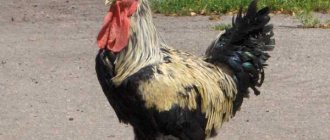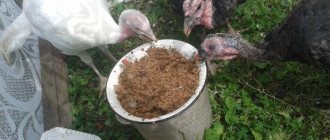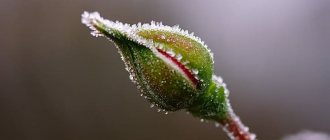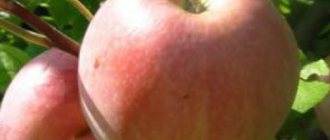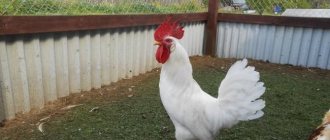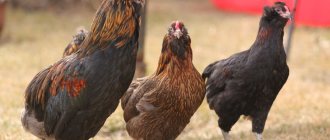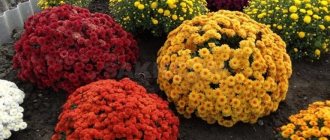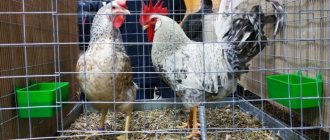Peculiarities
Turkeys come from the New World (as America was once called). In the 16th century they were brought to Spain, which has a mild climate. Subsequently, the population spread throughout Europe. The most favorable climate for birds is considered to be warm and temperate. All individuals do not tolerate dampness or cold winds, therefore, when the temperature drops below 0°C, it is necessary to insulate the house as much as possible and prevent even a short-term drop in temperature below -5°C.
It is not recommended to keep turkeys with birds of other species. Turkeys are “characteristic”, uncooperative individuals that can be carriers of diseases that are not typical for other bird species (for example, chickens). In addition, by placing turkeys with chickens for the winter, there is a high probability that the chickens will always be hungry. Turkeys are much more agile, and the food in the feeders will mainly go to them. All this indicates the advisability of building a turkey poultry house for the winter. The area of the room should correspond to the calculation: 1 m2 for 2 turkeys.
Optimal indoor temperature for keeping turkeys in winter
In order to provide your birds with comfortable living conditions in the house and try to make the wintering process as easy as possible for them, it is recommended to insulate the room so that the average daily temperature inside does not fall below -5°C. This is the extreme limit of indoor temperature for keeping turkeys.
Among home farmers, it is believed that the optimal environmental temperature for the normal functioning of turkeys’ bodies in winter is the range from -1 ° C to +3 ° C. It must be remembered that too high a temperature inside the house in winter can significantly harm your birds, since they will suffer significantly from temperature changes when going out for a walk and returning back to the room.
Temperature
Knowing how turkeys tolerate winter and frost, you can set up a turkey poultry house, eliminating all negative factors that affect the growth and egg production of birds. So, a few important facts about turkeys:
- Temperature endurance. The lowest temperature in winter for turkeys, at which they can walk without harm to their health, is -15°C.
- Optimal temperature in a turkey poultry house in winter. If it is -15°C or lower outside, it is permissible to reduce the temperature in the room to -3-5°C, but at this time it is worth taking measures to insulate the turkey poultry so that the temperature rises to +1...+3°C.
- Sensitivity to snow. Turkeys' legs are not protected from the cold, so the walking area must be thoroughly cleared of snow.
Now that we know at what temperature to keep turkeys in winter, measures should be taken to insulate the turkey poultry.
Temperature conditions in the poultry house
In the most severe frost conditions, it is allowed to reduce the air temperature in the poultry house to minus three degrees Celsius. If the temperature outside rises to minus fifteen degrees Celsius, then the climate temperature in the poultry house can be reduced to minus five. This is due to the fact that at very low temperatures humidity increases.
To level out this phenomenon, a gap of two degrees is provided. A positive temperature of one degree Celsius is considered comfortable living conditions for all breeds of turkeys, regardless of whether they are adapted to frost or not. At this temperature, turkeys’ bodies develop comfortably, gain weight, and the egg production corresponds to the declared breed.
Warming and preparing bedding
In regions where the temperature in winter does not fall below 10°C, it is enough to maintain natural heat without using additional heating sources. The main thing is to eliminate sources of drafts in the turkey poultry as much as possible and insulate the floor coverings.
Straw, peat or sawdust are used as bedding material. The bedding rots and deteriorates, so the novice farmer needs to regularly clean turkeys in the winter. Straw flooring is less durable and requires replacement every 10 days. The peat and sawdust layers must be changed every 3 weeks. You should pay attention to the condition of the litter, and if it is damp or lumpy, it should be replaced earlier.
A little bit of history
In many developed countries, turkey meat is one of the main decorations of the holiday table. It is used not only for preparing single dishes, but is also part of incredibly tasty smoked meats. For large feasts, a chicken carcass will not be enough, but a 20-kilogram overseas bird will be enough for everyone.
Turkeys already had more than 1,000 years of domestic experience behind them by the time they arrived on the European continent along with the ship of Christopher Columbus.
Turkeys were brought to Europe thanks to the efforts of Christopher Columbus.
Turkeys are considered large poultry: males easily gain 20 kg, and females - 10 kg or even more. Differences in weight are observed already after reaching 20 days: males are approximately 30% heavier than females. By the 4th month, the weight of the bird begins to increase rapidly: in females the weight indicator increases by 170 times, and in males by 200 times. If we transfer this phenomenon to a person, then at 4 months he would weigh 700 kg.
Lighting
In industrial conditions, birds grow without natural light, but poultry farms are equipped with artificial lighting sources. This is necessary so that the egg production of birds remains at a high level. At home, turkeys are raised in barns, where there are often windows, and daylight easily illuminates the homemade turkey poultry, but with short daylight hours it is not enough.
To maintain egg production, turkeys need light, and the duration of daylight should be at least 14 hours.
The same rule applies to the growth of young animals. Turkey poults also need light. Even if there are windows in the turkey house, there will not be enough sunlight, and with the onset of evening twilight in winter it is necessary to connect artificial lighting sources.
Sand and ash baths for the prevention of parasites
During the cold season, any poultry needs additional protection from a variety of parasites. The most common type of parasite found on any poultry with developed plumage is a variety of down feather eaters. In total, modern science knows about 17 species of these insects that actively parasitize turkeys.
Since the immune system of your charges and their bodies as a whole are not in the most active state (due to the molting period, a decrease in the percentage of green food in the diet and a slowdown in metabolic processes in the body), it would not be superfluous to help the birds cope with parasites with the help of sand. ash baths.
Organizing such a preventive measure is quite simple - just place large containers (such that the entire bird can fit in them) within the reach of the birds and fill them with a mixture of sand, dry wood ash and dry clay in proportions 1:1:1. If the animal suddenly begins to be bothered by parasites, it will independently begin to fight them, conducting “bathing” sessions (allowing streams of sand to move freely between the feathers). This will effectively clean the feathers of birds from parasites, larvae and their eggs.
Feeding
Raising birds in winter requires special organization of feeding. At lower temperatures, birds spend more energy, so the feed should be more nutritious and balanced. So, what to feed turkeys in winter:
- Grain: corn, barley, wheat. Grain feed is provided in the morning and evening.
- Compound feeds - special balanced mixtures for birds. They are sold in packages with a description of the feeding regime (Starter, Finisher, Spasskie mixed feed, Fegel and many others).
- Juicy feed. For the winter, to feed turkeys, they stock up on carrots, beets, potatoes (they are given boiled), and cabbage. As an additive you can use pine needles, ground chestnuts, and acorns.
Valuable additives in the diet of turkeys are shells and ground chalk. They contribute to the formation of the skeleton.
Use on your websites and blogs or on YouTube adsense traffic auto click bot
Turkeys need salt as a source of potassium, so all food placed in feeders must be slightly salted. On day 1, the bird is given about 0.5 g of salt.
It is important not to forget about filling the drinkers. Turkeys must have constant access to fresh drinking water.
In winter, it is necessary to monitor the weight of birds. If the weight of a male exceeds 19 kg, and a female exceeds 12 kg, this means that they have begun to grow fat. Birds become slow and apathetic.
In winter, turkeys are fed at least 3 times a day. For laying hens - a little more often: 4-5 times a day.
On average, 1 bird needs up to 500 g of feed per day.
Maintenance and care at home
The productivity of the livestock depends on the arrangement of the poultry house, the temperature and air humidity in it, as well as on the food supply of the birds.
Did you know? Every year in the United States of America, housewives bake more than 270 million turkeys for Thanksgiving, that is, one for every resident of the country.
Content Features
Experienced poultry farmers know that poultry birds grow poorly in cold rooms, since the feed they consume is not used to build fat and muscle mass, but for additional heating.
Excessive heat is also contraindicated, since it is the main reason for the decrease in egg production, live weight of the bird and deterioration in the quality of its eggs.
To create comfortable conditions for the bird, take care of the optimal temperature, eliminate dampness, arrange cozy perches and proper lighting.
Optimal growing conditions
Turkeys grow well if kept at:
- temperature +12…+16°С;
- air humidity at 55–60%;
- complete absence of drafts and dampness (this requires not only a good ventilation system in the poultry house, but also a thick layer of bedding made of hay, peat or sawdust);
- daylight hours for at least 14 hours (in winter, in clear weather, it is advisable to let the wards out for a walk; they are not afraid of frost and sudden temperature changes, but if they stay in such conditions for a long time, they can get frostbite in their limbs and catch a cold).
Did you know? Turkey meat has hypnotic properties. This is due to the tryptophan it contains, which, when interacting with amino acids, calms the central nervous system
.
Content requirements
The main mistake of novice poultry farmers is that they keep different birds in the same room. Remember: turkeys must live separately, so they require individual housing with designated compartments for females and males. They are released for walking at the same time.
The best option for keeping such birds in winter is a heated barn. If you don’t have the time and resources to build one, you can get by with a polycarbonate greenhouse. It has a suitable microclimate and enough light.
Video: Keeping turkeys in a greenhouse
There should be no gaps in the structure where the bird is kept. When using polycarbonate greenhouses, this aspect loses relevance, since we are talking about an airtight structure. However, such buildings require additional internal cladding with plywood sheets. This is done to prevent turkeys from damaging the polycarbonate.
It is important that indoors there are:
- a thick layer of bedding (a cold floor is often the cause of colds in livestock) with regular renewal;
- free space (calculated at the rate of 1 m² for each adult).
In addition, birds must have access to a walking area. It is fenced and covered on top with a strong metal mesh to prevent bird flights.
Important! It is recommended to place turkey nests in dark corners of the room. Do not install red lamps above them, as aggressive lighting will provoke the hens to crack the eggs.
In winter, do not forget to clean the enclosure from snow and be sure to place roughage (hay, branches) in it.
Poultry house arrangement
In order to provide turkeys with comfortable conditions, novice poultry farmers need to properly equip the room from the inside. It is important that the necessary attributes are present in minimal quantities and do not interfere with residents.
At this stage you should pay attention to:
- Perches . They are made in the form of poles with a diameter of about 6 cm, placed at a level of 70–75 cm from the floor in the shaded areas of the room opposite the front door. In the case of a multi-tiered installation, maintain the indentations so that birds sitting at the top do not stain the neighbors below with droppings. When installing perches, provide a space of 60–65 cm for each individual.
- Nests . How many are needed depends on the number of livestock. If there are about 5 females in the house, one nest is enough, which is recommended to be installed on a one and a half meter elevation, preferably on a load-bearing wall of the structure. The design should be 45–50 cm deep, 35–40 cm high. Some owners use ready-made boxes, knocking them together into several tiers. In this case, a sloping roof is required on top. This will prevent unwanted bird roosting. The inside of the nest is covered with straw or hay and a dummy egg is placed to lure the hens.
- Feeders and drinkers. You can build them yourself or buy them. The main thing is that the containers are convenient and practical. Remember that it is better to pour dry food into wooden products, and wet mash into metal or glass. Lattice structures are ideal for coarse and succulent feed.
Important! In a turkey house, no more than 4 chicks should be placed per square meter. If planted too closely, young animals will stop developing.When choosing feeders and drinkers, special attention should be paid to their shape, since small rectangular shapes are aimed at chickens, and trough-shaped ones are for adults. The latest structures, if there are separate compartments and bars on them, can be placed outside the aviary, providing birds with access to them. It is recommended to place such utensils in the poultry house under lamps on the floor or hanging from a vertical support.
- Fonts . They are mandatory in turkeys’ homes because they prevent infection by parasites. For such purposes, you can use any containers of suitable depth and width, filling them with wood ash, river sand or fine grain granules.
Room heating
Turkeys feel comfortable in moderate temperatures. If they are kept in winter in regions with a harsh climate, then a heating system is required in the room.
You can set it up using:
- electric heaters;
- gas boilers;
- infrared lamps;
- heat collectors;
- bourgeois (like “Buleryan”);
- wood stoves.
Did you know? America is the homeland of turkeys. This bird came to Europe thanks to Christopher Columbus.
Before you start arranging heating for the turkey poultry, you need to caulk all the cracks and insulate the window openings and walls. At the same time, you should not ignore safety rules, and you also need to eliminate the risk of damage to feathered residents.
Organization of walking
In winter, it is advisable to let the livestock go outside every day for a short walk, with the exception of inclement days. For these purposes, poultry farmers build a spacious aviary next to the turkey poultry.
In addition to fencing, experienced owners advise protecting it from wind and drafts by planting tall shrubs on the north side. Make sure that the birds have the opportunity to independently go out for a walk and return indoors in bad weather.
Mandatory attributes on the walking area are:
- feeders (only for dry and roughage);
- drinking bowls (make sure their contents do not freeze).
Important! The thickness of the bedding for turkey poults under 4 months of age must be at least 30 cm, and for adults 15 cm is sufficient. Hay and straw are replaced after 10 days, and peat and sawdust can be changed after 20 days.
Feeding
In the cold season, the bird will need much more feed, which is due to the need to generate energy for warmth, as well as the development of the body. Read below about the differences between the diets of turkey poults and adults.
Adult turkeys
If in summer poultry independently provides itself with the necessary greens while grazing, then in winter you need to take care not only of the required amount of feed, but also of its balance and calorie content.
The bird needs three meals a day. It is recommended to give her feed and grain mixtures in the morning and evening. They take a long time to digest and supply the body with necessary substances. For daytime use, wet mash and succulent food are suitable. They are poured into feeders placed indoors, since such food can freeze outside.
Please note that grain alone is not enough for birds. It is important that in winter they consume high-quality hay, which is pre-steamed in boiling water, as well as vitamin supplements in the form of acorns, chestnuts, and pine needles.
You can familiarize yourself with the components necessary in the winter diet of adult turkeys in the table below, and also compare their needs, depending on the season.
| Necessary feed | Daily feed intake for adult turkeys (in grams per head) | |
| Winter - autumn | Spring - summer | |
| Cereals (barley, wheat, corn) | 155 | 152 |
| Wheat bran | 32 | 22 |
| Meal, cake | 9 | 19 |
| Fish and meat and bone meal | 4 | 8 |
| Hay dust (can be replaced with grass flour) | 25 | 14 |
| Juicy food including carrots | 200 | 155 |
| 27 | 33 | |
| Grass | 220 | 130 |
| Chalk, shells | 8 | 12 |
| Salt | 1 | 1 |
Turkey poults
The feed requirements of chicks depend on the age and characteristics of the breed. Their diet differs from adult turkeys in the need to introduce cottage cheese, yeast, boiled eggs and potatoes, and onion greens. All these products are available in winter.
Keep in mind that about 90% of the food eaten by turkey poults is spent on vital processes of the body, and only 10% is spent on the formation of muscle mass.
The approximate daily ration for young animals of any age in winter is calculated in the table below:
| Necessary feed | Daily feed intake for turkey poults of different ages (in grams per head) | |
| 1–10 days | 11–25 days | |
| Cereals (barley, wheat groats, dwarf) | 9 | 13 |
| Corn grits | 5 | 7 |
| Wheat bran | 6 | 8 |
| Onion greens | 9 | 16 |
| Carrot | 6 | 11 |
| Boiled potatoes | — | 6 |
| Cottage cheese | 6 | 11 |
| Return | 11 | 13 |
| Meat and bone (or fish) meal | 2 | 6 |
| Boiled eggs | 2 | — |
| Yeast | 0,3 | 0,4 |
| Salt | — | 0,2 |
| Chalk, crushed shells | 0,6 | 0,9 |
| Fine gravel | — | 0,2 |
| Chopped hay dust | 4 | 14 |
Prevention and treatment of diseases
Poor diet, unsanitary conditions and inadequate housing conditions are the main causes of avian diseases. Their causative agents are often pathogenic microorganisms. In addition, turkeys are sensitive to changes in environment and stressful situations. Because of this, they can suddenly shed their plumage and get sick.
Important! To prevent birds from getting sick, before planting them, the turkey poultry must be disinfected with a solution of soda ash or creolin. Indoor utensils, including feeders and drinking bowls, are disinfected with ash lye, which is prepared at the rate of 1 kg of wood ash per 5 liters of warm water
.
Turkeys often suffer from:
- Respiratory mycoplasmosis . The infection is transmitted by airborne droplets and is expressed by general weakness, inflammation of the eye sockets, blurred vision, mucous discharge from the nose and eyes, loss of productivity, loss of coordination and rapid breathing. The causes of the disease are a cold poultry house, dampness, drafts and excessive walking outside in frosty times. If measures are not taken, the livestock will die. Treatment is carried out by adding chlortetracycline and oxytetracycline to wet food. Also, to increase the immunity of an infected bird, an increase in the daily dose of greens (especially onions) and vitamins is indicated.
- Tuberculosis . The causative agents of the disease are transmitted to turkey poults through dirty eggs, bedding, water, settle in the lungs and are difficult to treat. Infected individuals fall on their feet, eat poorly, show apathy and lose weight. They develop specific growths on unfeathered areas. There is currently no antidote. To preserve the livestock, it is recommended to dispose of sick animals and thoroughly disinfect the premises.
- Histomonosis. The infection develops when there are gross violations of keeping and caring for livestock. Often, outbreaks of infection occur when turkeys and geese, ducks, and chickens are housed together. The disease progresses rapidly and is expressed by green diarrhea, lack of activity, apathy, and lack of appetite. Without drug therapy, death is inevitable, since the sick individual's joints and internal organs are affected. Treatment is carried out with Furazolidone, Osarsol, Phenothiazine or Brometronide.
Video: Histomoniasis in turkeys
- Helminthiasis . The disease is dangerous due to the risk of human infection through the consumption of meat and egg products. Sources of infection are already infected inhabitants of the poultry house and other contacting birds, water, food, dirty drinking bowls of the feeder, soil in the enclosure. Parasites exhibit vital activity with weak external symptoms. Only in advanced cases is the weakness and lifelessness of the bird noticeable, so it makes sense to periodically give turkeys a therapeutic and prophylactic course of medications (Phenothiazine, Avatek, Filixan, Piperazine, Pirantel).
- Smallpox . Infection occurs through contact with infected individuals, as well as through insects, common food and water. The disease is manifested by apathy, lack of appetite, ruffled feathers and a characteristic rash on the legs, head and unfeathered skin. The disease is difficult to treat, so at the first symptoms, sick individuals are slaughtered and disposed of. For prevention purposes, vaccination with fetal serum is recommended.
Street content
Regardless of what temperature turkeys can withstand outside in winter, winter keeping of these poultry in cold weather is not practiced. There are several reasons for this:
- Inability to stay outside for a long time at sub-zero temperatures. Turkeys can withstand temperatures around -5°C for up to 3 hours. A longer stay in the cold will lead to an increase in disease, a decrease in egg production, and keeping turkeys will turn from a profitable business into an unprofitable one.
- Very sensitive limbs. Domestic turkeys often experience frostbite on their feet. Even short-term walking of birds in the cold requires careful clearing of snow from the area. Ideally, it is recommended to cover the surface of the ground with branches of pine needles, scatter food and small shells in bulk. Digging for food is a favorite activity for turkeys. Such a walk will only bring benefits and improve the health of the birds.
In order not to bother with constant cleaning of the winter walking area, it is advisable to install a canopy with a slight slope.
About walking
Farmers know that turkeys don't like to be outside in the winter. In order for the birds to stay longer in the snow-covered yard, breeders prepare nettle brooms for them; they will begin to approach them and peck the nettle leaves. The trick is effective, and the bird will walk longer, and will also receive a variety of vitamins.
Sedentary birds will become obese, and this will have a bad effect on their health. In cold weather, turkeys should spend 2 hours outside. To do this, the owner will equip an enclosure for them on the south side of the site. It is correct to make an exit into it from the poultry house. If there is no roof, you need to remove snow from the site so that your pets’ paws don’t get cold.
Tips for quickly assembling a turkey poultry house for the winter
A relatively inexpensive material that is excellent for building a turkey poultry house is polycarbonate. This is a light-transparent material that holds heat excellently. The use of polycarbonate solves 2 problems at once: heat preservation and improved lighting.
The material has one significant drawback: fragility in frost. If you do not expose polycarbonate to mechanical stress, it will remain safe and sound. However, turkeys are active birds, and sometimes aggressive, and can break a wall or floor covering with their beak. Therefore, it is recommended to protect the building from birds: cover the floor with slate or boards, and protect the walls with the same material at a height of approximately 1 m from the floor.
Removable feeders must be installed indoors.
The advantage of using a polycarbonate turkey house is the ability to quickly transform into a greenhouse. In the spring, it is necessary to move the turkeys under a canopy, remove the floor in the turkey house, move the feeders, and use the room as a greenhouse for early sowing of vegetables.
Preparing for winter
A good owner prepares for winter from the beginning of summer. The fact is that in winter turkeys need a comfortable, spacious room. An old chicken coop can accommodate several birds, but if you have a large flock, it is better to build a separate poultry house for it. During construction, at least a square area of area must be allocated for each bird . In the summer, for comfortable keeping of domestic turkeys, the main thing is to have an extensive range, and in winter, the birds should have enough space in the house.
You need to think in advance about how to heat the room in winter. There are two types of heating for poultry houses:
- Natural heating, when the room temperature is maintained in winter by retaining heat. To achieve this effect, the owner must caulk all openings, except for the ventilation one, and insulate the walls at the stage of building the room. However, in very severe frosts, this method does not fulfill its purpose, and the room must be heated additionally.
- Artificial heating, for which electrical appliances, gas boilers, stoves, infrared appliances or lamps are used.
If the owner has not approached heating issues in advance, then the living conditions may not be comfortable enough and the turkeys will get sick or die.
conclusions
When breeding turkeys in winter, it is important not to miss the following key points:
- Turkeys can withstand temperatures in the barn of up to -5°C in winter, but the farmer’s task, when the temperature drops to this level, is to take measures so that it rises to above zero. Further reduction is unacceptable.
- The flooring in the turkey house must be dry. The frequency of its replacement depends on the type of material, however, if the coating becomes damp before the replacement date, it is necessary to quickly lay a new one.
- Turkeys need light 14 hours a day. In winter, there is not enough sunlight, and lighting devices will be needed.
- In winter, turkeys need to be fed three times a day with balanced feed, but avoid overeating and the development of obesity in birds.
- Walking turkeys in winter is possible, but it should be short-lived, with mandatory preliminary cleaning of the winter area.
How turkeys endure winter depends only on the farmer. If the turkey house is insulated, lit, and there is enough food for the birds, then the winter hut will take place without loss of productivity of the household (farm).
Poultry house insulation
Features of preparation for winter of a room for keeping turkeys depend on the temperature inherent in the region. If winters are moderately cold (up to -15 °C), then it is sufficient to insulate the turkey poultry well, thereby preventing heat loss. To achieve this, the following activities are carried out:
- sealing all cracks (except for ventilation holes);
- insulation of walls with materials such as foam concrete, glass wool, polystyrene foam;
- minimizing the penetration of cold air into the house (a vestibule is provided; in extreme cold, the windows are covered with thick fabric or polyethylene);
- the room is provided with additional lighting (during lamp operation, the lamps emit additional heat)
If the thermometer drops below -15 °C, the room is heated - use (optional):
- infrared devices;
- electric heaters;
- gas boilers;
- potbelly stoves.
When installing any heating device, safety precautions must be taken to avoid fire and injury to birds when they come into contact with heated parts of the equipment.
The Importance of Ash Baths
The presence of skin or feather parasites causes a lot of trouble not only for turkeys, but also for owners, because pets will have to be treated, and if this is not done in a timely manner, you can get a very disastrous result.
Blood-sucking insects cause discomfort to the bird: turkeys may begin to peck at themselves in an attempt to get rid of the itch. In this case, the skin is injured, which can lead to pecking and attacks on a weakened individual. Cannibalism often ends in death.
To prevent the appearance of parasites, place a container filled with a mixture of ash and sand in the room. The bird will take a dry bath and preen its feathers, which helps maintain hygiene. All the owner needs is to ensure that the mixture does not run out.
Keeping turkeys in a polycarbonate greenhouse in winter
In summer, keeping turkeys at home does not present any difficulties. Birds can spend most of the day grazing, which significantly reduces feeding costs. In winter, the usual food is not enough and it is necessary to properly formulate a diet for the birds and create conditions in the poultry house.
It is a good idea to keep turkeys in a polycarbonate greenhouse. In winter, this room is usually empty. Why not use it more rationally and start turkeys? This bird is not picky about living conditions. In frosts down to −15 degrees, there is no need to install a heater for turkeys, because thanks to their thick down and dense plumage, turkeys tolerate such temperatures well.
Due to the fact that polycarbonate is transparent, during the daytime there will be enough light inside the polycarbonate greenhouse. Artificial lighting should be turned on at dusk. The total day length for turkeys should be about 14-15 hours.
How to equip a polycarbonate greenhouse so that turkeys feel comfortable indoors? Poultry farmers recommend paying attention to the following aspects, namely:
- It is good to insulate the bedding for the winter. The cold floor of a greenhouse is one of the main sources of heat loss in winter. A dense layer of hay, straw, peat, and sawdust will be sufficient. The main thing is not to let the room temperature drop below −5 degrees.
- Eliminate drafts. All cracks in the walls must be sealed. They will be a source of heat loss and drafts. If this is not done, the birds will often suffer from colds.
- Place a container with sand and ash inside the polycarbonate greenhouse. Turkeys love to bathe in these baths. This relieves them of various parasites (feather eaters) that grow on the skin and among the feathers.
- If the winter is expected to be harsh, it is recommended to add additional insulation to the walls. Plywood, chipboard or available materials are suitable for this. In this case, the cold will not emanate from the wall and the birds will feel warmer. Protecting the walls with slate and chipboard sheets is also recommended to prevent turkeys from damaging the greenhouse with their powerful beaks.
Little trick
Turkeys often suffer from parasites in their feathers from careless owners in winter. To avoid this misfortune, be sure to leave a container filled with ash and sand in the house. Poultry uses a sand-ash bath to prevent and control parasites.
Don't forget that turkeys, like chickens, constantly peck at small gravel and pebbles. Separately from the food, pour crushed shells, chalk and charcoal into the trough. This is necessary for digestion.
There is nothing particularly difficult about keeping turkeys in winter. If the owner is not lazy and prepares for low temperatures and short days, then his poultry house will overwinter in warmth and comfort, without losses.
